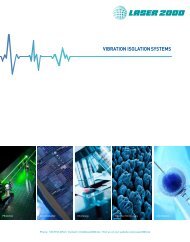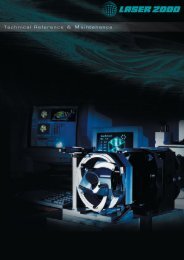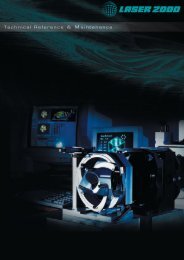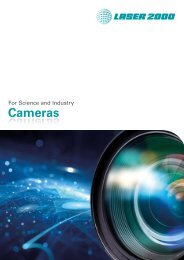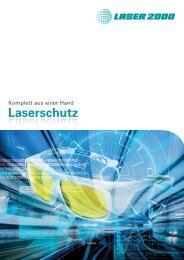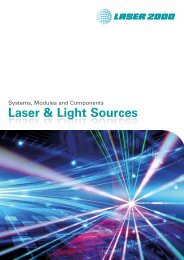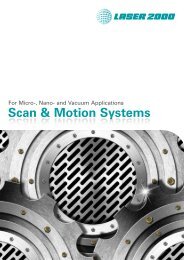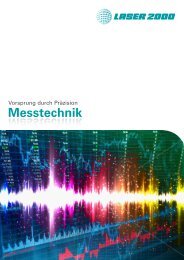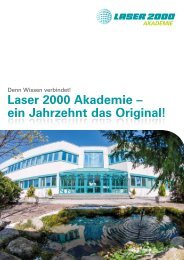Semrock Master Catalog 2018
Semrock Master Catalog 2018
Semrock Master Catalog 2018
Create successful ePaper yourself
Turn your PDF publications into a flip-book with our unique Google optimized e-Paper software.
Working with Optical Density<br />
Optical Density – or OD, as it is commonly called – is a convenient tool to describe the transmission of light through a highly<br />
blocking optical filter (when the transmission is extremely small). OD is simply defined as the negative of the logarithm (base<br />
10) of the transmission, where the transmission varies between 0 and 1 (OD = – log 10<br />
(T)). Therefore, the transmission is<br />
simply 10 raised to the power of minus the OD (T = 10 – OD ). The graph below left demonstrates the power of OD: a<br />
variation in transmission of six orders of magnitude (1,000,000 times) is described very simply by OD values ranging between<br />
0 and 6. The table of examples below middle, and the list of “rules” below right, provide some handy tips for quickly<br />
converting between OD and transmission. Multiplying and dividing the transmission by two and ten is equivalent to<br />
subtracting and adding 0.3 and 1 in OD, respectively.<br />
Optical Density<br />
Optical Density<br />
6<br />
5<br />
4<br />
3<br />
2<br />
1<br />
0<br />
1E-6 1E-5 1E-4 1E-3 0.01 0.1 1<br />
Transmission (0-1)<br />
4<br />
Edge 5 Filters vs. Notch Filters for Raman Instrumentation<br />
6<br />
RazorEdge ® Filter Advantages: Edge Design<br />
7<br />
Notch Design<br />
Steepest possible edge for Laser looking Line at the smallest<br />
8<br />
Stokes 610 615 shifts 620 625 630 635 640 645 650 655 660<br />
Wavelength (nm)<br />
0<br />
0<br />
1<br />
1<br />
2<br />
2<br />
3<br />
3<br />
the laser 4 wavelength (on <strong>Semrock</strong> U-grade edge filters), these filters don’t need to be angle-tuned!<br />
4<br />
5<br />
5<br />
6<br />
Edge Design<br />
6<br />
7<br />
Notch Design<br />
Edge Design<br />
Laser Line<br />
7<br />
Notch Design<br />
shift toward 8 shorter wavelengths as the angle of incidence is increased from Laser Line 0° up to about 14°.<br />
610 615 620 625 630 635 640 645 650 655 660<br />
8<br />
610 615 620 625 630 635 640 645 650 655 660<br />
Wavelength (nm)<br />
Wavelength (nm)<br />
Optical Density<br />
Transmission (%)<br />
TECHNICAL NOTE<br />
100<br />
90<br />
80<br />
70<br />
60<br />
50<br />
40<br />
30<br />
20<br />
10<br />
0<br />
0<br />
1<br />
2<br />
TECHNICAL NOTE<br />
3<br />
Largest blocking of the laser line for maximum<br />
laser rejection<br />
Edge Measured<br />
Notch Measured<br />
Laser Line<br />
550 600 650 700 750 800<br />
Wavelength (nm)<br />
Optical Density<br />
Optical Density<br />
0<br />
1<br />
2<br />
3<br />
4<br />
5<br />
Transmission OD<br />
1 0<br />
0.5 0.3<br />
0.2 0.7<br />
0.1 1.0<br />
0.05 1.3<br />
0.02 1.7<br />
0.01 2.0<br />
0.005 2.3<br />
0.002 2.7<br />
0.001 3.0<br />
6<br />
Edge Design<br />
7<br />
Notch Design<br />
Laser Line<br />
8<br />
610 615 620 625 630 635 640 645 650 655 660<br />
Wavelength (nm)<br />
Optical Density<br />
0<br />
1<br />
2<br />
3<br />
4<br />
5<br />
The “1” Rule<br />
T = 1 → OD = 0<br />
The “x 2” Rule<br />
T x 2 → OD – 0.3<br />
The “÷ 2” Rule<br />
T ÷ 2 → OD + 0.3<br />
The “x 10” Rule<br />
T x 10 → OD – 1<br />
The “÷ 10” Rule<br />
T ÷ 10 → OD + 1<br />
StopLine ® Notch Filter Advantages:<br />
Measure Stokes and Anti-Stokes signals simultaneously<br />
Greater angle-tunability and bandwidth for use with variable<br />
laser lines<br />
The graph below left illustrates the ability of a long-wave-pass (LWP) filter to get extremely close to the laser line. The graph<br />
in the center compares the steepness of an edge filter to that of a notch filter. A steeper edge means a narrower transition<br />
width from the laser line to the high-transmission region of the filter. With transition widths guaranteed to be below 1% of<br />
The graph on the right shows the relative tuning ranges that can be achieved for edge filters and notch filters. <strong>Semrock</strong> edge<br />
filters can be tuned up to 0.3% of the laser wavelength. The filters shift toward shorter wavelengths as the angle of incidence<br />
is increased from 0° to about 8°. <strong>Semrock</strong> notch filters can be tuned up to 1.0% of the laser wavelength. These filters also<br />
6<br />
Edge Design<br />
7<br />
Notch Design<br />
Laser Line<br />
8<br />
610 615 620 625 630 635 640 645 650 655 660<br />
Wavelength (nm)<br />
NIR Filters Mirrors Polarizers<br />
Edge<br />
Filters<br />
Dichroic<br />
Beamsplitters<br />
Laser-line<br />
Filters<br />
Laser Diode<br />
Filters<br />
Notch<br />
Filters<br />
Lamp Clean-up<br />
Filters<br />
0<br />
(%)<br />
100<br />
90<br />
80<br />
70<br />
Density<br />
1<br />
2<br />
3<br />
107<br />
More



